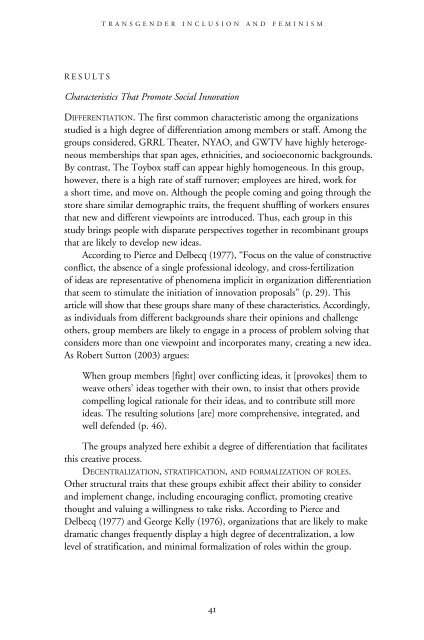2006 - School of Social Service Administration - University of Chicago
2006 - School of Social Service Administration - University of Chicago
2006 - School of Social Service Administration - University of Chicago
Create successful ePaper yourself
Turn your PDF publications into a flip-book with our unique Google optimized e-Paper software.
TRANSGENDER INCLUSION AND FEMINISM<br />
RESULTS<br />
Characteristics That Promote <strong>Social</strong> Innovation<br />
DIFFERENTIATION. The first common characteristic among the organizations<br />
studied is a high degree <strong>of</strong> differentiation among members or staff. Among the<br />
groups considered, GRRL Theater, NYAO, and GWTV have highly heterogeneous<br />
memberships that span ages, ethnicities, and socioeconomic backgrounds.<br />
By contrast, The Toybox staff can appear highly homogeneous. In this group,<br />
however, there is a high rate <strong>of</strong> staff turnover; employees are hired, work for<br />
a short time, and move on. Although the people coming and going through the<br />
store share similar demographic traits, the frequent shuffling <strong>of</strong> workers ensures<br />
that new and different viewpoints are introduced. Thus, each group in this<br />
study brings people with disparate perspectives together in recombinant groups<br />
that are likely to develop new ideas.<br />
According to Pierce and Delbecq (1977), “Focus on the value <strong>of</strong> constructive<br />
conflict, the absence <strong>of</strong> a single pr<strong>of</strong>essional ideology, and cross-fertilization<br />
<strong>of</strong> ideas are representative <strong>of</strong> phenomena implicit in organization differentiation<br />
that seem to stimulate the initiation <strong>of</strong> innovation proposals” (p. 29). This<br />
article will show that these groups share many <strong>of</strong> these characteristics. Accordingly,<br />
as individuals from different backgrounds share their opinions and challenge<br />
others, group members are likely to engage in a process <strong>of</strong> problem solving that<br />
considers more than one viewpoint and incorporates many, creating a new idea.<br />
As Robert Sutton (2003) argues:<br />
When group members [fight] over conflicting ideas, it [provokes] them to<br />
weave others’ ideas together with their own, to insist that others provide<br />
compelling logical rationale for their ideas, and to contribute still more<br />
ideas. The resulting solutions [are] more comprehensive, integrated, and<br />
well defended (p. 46).<br />
The groups analyzed here exhibit a degree <strong>of</strong> differentiation that facilitates<br />
this creative process.<br />
DECENTRALIZATION, STRATIFICATION, AND FORMALIZATION OF ROLES.<br />
Other structural traits that these groups exhibit affect their ability to consider<br />
and implement change, including encouraging conflict, promoting creative<br />
thought and valuing a willingness to take risks. According to Pierce and<br />
Delbecq (1977) and George Kelly (1976), organizations that are likely to make<br />
dramatic changes frequently display a high degree <strong>of</strong> decentralization, a low<br />
level <strong>of</strong> stratification, and minimal formalization <strong>of</strong> roles within the group.<br />
41
















